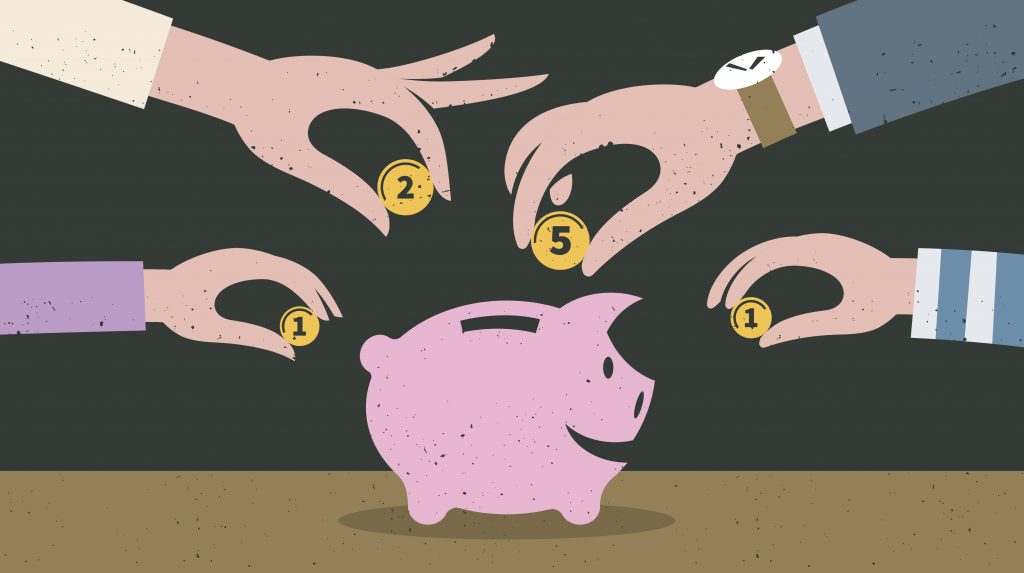
Saving money should be simple, right? Spend less than you earn and save what’s left. If only it felt that easy. While most of us like to sprint, saving money requires the endurance of running a financial marathon. Whether you’ve lost wages during the pandemic, you’re concerned about rising prices at the store, or saving money is a new goal, here are some out-of-the-box ideas to help you reach your money-saving goals.
Who do you know?
You may not think your family and friends are related to you being able to save money, but sometimes they can be key players in your success.
Barter. This may sound old school, but sometimes classic ideas are the best ones! Are you good at baking and decorating birthday cakes? Maybe you know someone who takes professional quality photos. Trade services with a friend and save.
Swap party! Get needed items for free by organizing a swap party online or in your home. Decide on a theme. Be clear about how to rate the condition of items and how many items each guest contributes. Send a listing of items and agree on socially-distanced ways to make exchanges.
Surround yourself with other savers. If you are always being asked to go shopping or out to eat, it can be hard to save money. Be honest with people about your intentions; lean on those you love for support if you’re struggling.
Embrace a giving spirit. This sounds counterintuitive to saving. But even when a bankroll is at its lowest, giving to someone whose needs are greater than yours helps grow an appreciation for what you have. Giving to others is also a motivator to save more so you can help others more.
Adjust your shopping habits.
Some shopping is necessary – the grocery store, the famous “Target run” – but sticking to your list and not overdoing it can be difficult.
Be a cherry picker. Try some Buy One Get One free items (BOGOs) at the nicer stores where, on average, the rest of the items in the store cost more. When cherry picking, buy the sales items, but save other shopping for less expensive stores.
Let someone else grocery shop for you. Grocery pick-up saves time, stops impulse buys, and keeps a running total during online shopping. If you go over your budget, uncheck unnecessary items before finalizing your order. Most groceries have waived pick-up fees during the pandemic, but if not, use coupons. Those coupons can save you more than the pick-up fee.
Be a Dollar Tree hugger. Dollar Tree has party items like helium balloons, paper plates, napkins, cutlery and greeting cards cheaper than most discount stores. It also has great prices on school and office supplies, craft supplies, seasonal decorations, over-the-counter medications and plastic containers.
Calculate your time. When you consider purchasing a non-essential item, calculate how many hours you have to work to pay for it. Is your time worth the purchase?
Money in the bank.
Being aware of how much money you have in various places can help you save more. As you see the totals increasing, you’ll feel good about your progress and be more motivated to stick with your money-saving habits.
Find missing money. You could be missing money and not even know it. For example, if you moved and a utility company owed you a deposit and couldn’t contact you, the money went into an unclaimed property fund. To learn more, visit usa.gov/unclaimed-money. To search your name for missing money, go to missingmoney.com or unclaimed.org.
Round up savings. Trick yourself into saving money. Round up to the next dollar when you record a check. At the end of the month, you’ll have a surplus. Your banking institution may offer this feature, or there are round up apps.
Start a “kick it” jar. Unhealthy habits and shopping addictions, like smoking or buying dozens of expensive shoes, are costly. Start a “kick it” jar. When the urge to splurge strikes, put money in the jar. As you see the money grow, so will resolve to kick the habit.
Keep the change. Collect loose change in a jar at the end of the day. A mere 50 cents a day savings will add up to almost $200 annually. As a family, save to pay off a debt or make a fun purchase. This also teaches kids good money-saving habits from an early age.
Home is where the savings are.
Due to the pandemic, most of us are spending more time at home than ever. Embrace simple, daily ways to save money where your family thrives.
Make restaurant-quality food at home. Dining out is a budget blower. Invest in a virtual cooking class, check out online cooking tutorials, or ask a friend who is a good cook for recipes.
Give up the ghost. Standby power, or phantom power, is energy that household items use when they are off, but plugged in. Items with digital displays and computers with monitors and printers can be standby power hogs. Unplug everything at night for a month. Monitor the electric bill for a difference. For more information, visit standby.lbl.gov.
Stop flushing money down the toilet! The bathroom is where the largest percentage of water is used in most American homes. The average toilet guzzles up to five gallons of water compared to the 1.3 gallons used by high-efficiency tanks. Also, opt for low-flow shower heads and faucets. For more information on water consumption, go to epa.gov and look for the WaterSense logo, or to figure individual household water consumption, go to csgnetwork.com and then type in “Water Consumption Calculator.”
YouTube it. Leaky toilet? Car repair that’s going to set you back hundreds of dollars? Look on YouTube for some DIY, fix-it tutorials. Even if you can’t fix it in the end, you’ll gain knowledge that will help you make the thriftiest choices when hiring help.
Cut the cord with cable. With so many streaming options available, you can save about $100 per month by getting rid of the classic cable package; that’s $1,200 a year in your pocket simply by adjusting your TV habits. Pro tip: be sure to count up how many streaming services per month you’ll need, as they can add up quickly.
-Janeen Lewis




